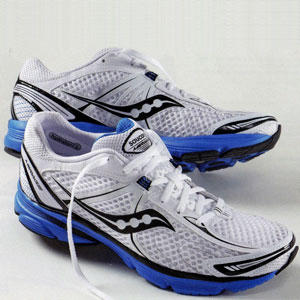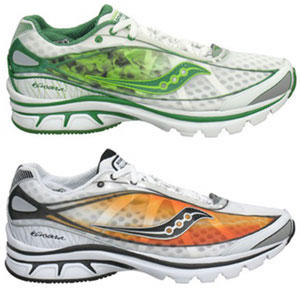
Saucony recognized, correctly and appropriately early, that the natural running trend was not just a fad, but a serious commitment to a technique by a group of committed runners. Saucony came to the market with the now very successful Kinvara, and yet again with the Mirage.
The Hattori is a nod toward the barefoot running market—which uses more or less the same running form principles—with a shoe flatter yet than the Kinvara and the Mirage. The Hattori is about as far as Saucony is willing to go toward Vibram’s Five Finger, and that’s pretty darned far. It’s extremely light in weight—a mere 125 grams—has no cushioning whatsoever, and is completely flat from heel to toe (zero offset).
Saucony was a traditional, family-owned, family-run, New England footwear company for upwards of a century. Then it got sold, twice, in a period of a few years (to Stride Rite and then to Payless Shoesource, its current owner), and it no longer remotely strikes that traditional, conservative posture. It is now decidedly lean-forward in bringing new ideas to market. The Hattori is another example. It’s Saucony’s first step in the barefoot running market. It’s a good step, but the utility of the Hattori in triathlon is very limited.
The upper is of a mesh material reinforced with seamless bonded synthetics and, unlike the Vibram Five Finger models, the Saucony has a shoe-like toe box (rather than an enclosure for each digit). I understand Saucony’s thinking. One limitation of the Five Finger motif is the difference in foot morphologies. The Hattori’s design sidesteps these issues.

At first blush you might suspect the replacement of laces with two Velcro straps wouldn’t be sufficient to give a secure fit. But Nike Sock Racers a generation ago proved otherwise, and in fact the Hattori’s straps execute closure just fine. After putting the shoes on—which is rather difficult especially with wet feet—the shoes feel snug and fit solid. The heel strap also does its work in securing the heel in the shoe.
So far so good.
I started with shorter runs because zero offset shoes are just a bit out of my wheelhouse for runs longer than 20 to 30 minutes. But even in these shorter runs I developed a pair of very nasty blood blisters under both my big toes. The reason, I believe, is that Saucony builds the shoes with a glued-in sockliner. Where the sockliner meets the upper and outsole there is a raised or bumpy edge. I couldn’t feel this immediately, but once I knew it was there it surprised me that the shoes are made this way. After my second run I felt this edge while running and thought it was just something I needed to get used to (it’s been a while since I last ran in barefoorters).
I’m confident I’m not the only one who’ll suffer this problem, but maybe there are those who’ll be immune. It will depend probably on running form, foot shape and how your big toe works with the edge of the sockliner. It’s definitely not a seamless and smooth transition from sockliner to the other structural elements of the shoe.
Hattoris are real barefoot running shoes and they feel like almost running completely unshod. And you should treat them this way. If you want to give these shoes a try you’re advised to make sure you’re already used to running with minimalist shoes, or take more than enough time to get your connective tissue adapted.
Saucony runs the Hattori in mens and womens specific models and colors. They run a half-size smaller than your regular running shoes.

[Editor’s note: Our capable editor-at-large for footwear Jeroen van Geelen owns Total Running, one of the more important running and triathlon retail establishments in The Netherlands.]


